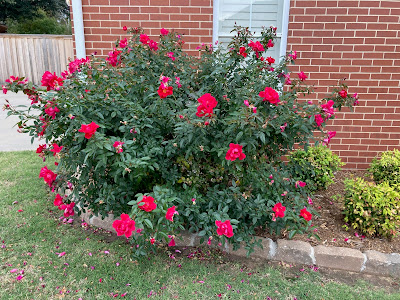‘The most beautiful things are not associated with money; they are memories and moments." Alec Wek
Memories are also made for others to share and that is where parents, schools, and communities come together. My sincere applause to the community of Miami, Oklahoma and all who made dreams come true this year with spectacular lights, colorful globes, the tallest Christmas Tree on Route 66, hot chocolate, fresh cookies and sweets. and a main street filled with families making memories for another generation.
I have realized in the last few decades that some of my memories are more like souvenirs. The word parade elicits large floats with scenes of Mary, Joseph, and baby Jesus; flat floats filled with children from the Girl Scouts, Boy Scouts, and community churches singing; grade schools with scenes from a Christmas play. The floats were larger than life and skirted and covered with chicken wire stuffed with napkins / Kleenex. (I had some experience in decorating floats when I attended NEO.) In my child’s imagination the floats were every bit as large as Macy’s Christmas parade. My eyes saw glittering shades of reds, greens, whites, yellows, pinks, orange, black, blues, all twinkling, or flashing like magic. Whereas our black and white televisions and newspapers only carried parades in black and white.
 |
| Wilson School |
My heart filled with joy and giggles when I heard over the loudspeakers Holly Jolly Christmas by Burl Ives. These are the moments that connect their generation with my generation.
A recent "Family Circus" cartoon shows the little boy holding a string of Christmas lights, then handing them to his father, the child declares,
"Christmas lights up the world."
In my hometown, Miami, Oklahoma, we attended every Christmas parade from 1955--the 1970's on the first Saturday night of December. Of course, my vision is in full color and always in my mind ready to roll. As a child, my point of view often caught the tires and lower levels of vehicles passing by pulling the radiant floats. Everything above me was giant in size. Looking up I saw astronomical golden yellow, blue, green, and red balls. Greenery and streaming lights were as high as the sky and unreachable as a child.
Vicki Martin, daughter of Russ Martin, recalls that their family had front row seats on the balcony of the Miami Hotel. Their dad announced the parade, for all at home who could not attend, from the KGLC station that was located on the second floor of the hotel.
What older people and former residents forget is that our parents and community were Making Memories for us. Fifty-years later parents and community are still Making Memories for their children and the children of Ottawa county. They are different memories, and they will have cameras and photos to recall plus bags of candy to remember the sweetness of the night.
Small towns still sent bands, cheerleaders, dance teams, "Shriners," shinny cars, fancy trucks, sleighs with toys and candy. The lights glowed overhead. People sang along, clapped and cheered for family and friends.
The children in front of us caught my attention. They jumped and hollered with joy and giggled at the sights on which their eyes feasted. A gray car, one I called the Bat Mobile drove by and I noticed the children's eyes and awes were thrilling. I wondered what a Bat Mobile would be doing in a Christmas parade? The truth of the matter is that it was a Tesla Truck, and didn't we have shiny new Mustang convertibles in our parades? I laughed out loud at myself and could hear in my head the lyrics to Rodgers and Hammerstein's song,
"Everything's up to date in Oklahoma. They've gone about as far as they can go. They went and built a skyscraper seven stories high about as high as a building ought to go."
What could be more joyful for a seventy-year-old woman than to hear the voices of children laughing, loving, and spirited in the moments...making memories.
The highlight for me was to see that Miami honored its best, Jane Osborn, as the Grand Marshall of the 2024 Parade. Her artic white hair, her joyful face aglow, and bright red lipstick set off her genuine smile and love for her hometown. She waved and we waved back. We knew her love and commitment had helped to bring our small town back to life.
Thank you Jane Osborn, Bill Osborn, Colby Allen Sign Company, Mayor Bless Parker, Bobby Poole, Debbie East and members of the community who worked together to make this parade of 2024 the best ever for the children with new businesses and brick buildings clean and inviting.
Footnote: Jonya and I drove old Route 66 going home on that Sunday from Miami to Sapulpa. You can't go wrong on Route 66....
For a glimpse of the olden days of black and white in Miami click on this link: 1950's Christmas Parades


















.jpg)
.jpg)
.jpg)
.jpg)





.JPG)
.JPG)








